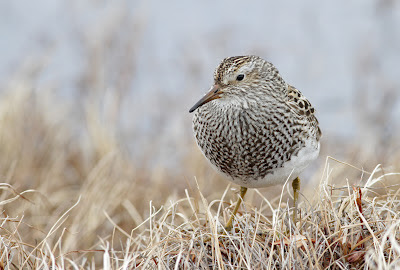Tent compound, the bottom right tent was my home for 5 weeks
I lay here writing, amid the yellow
light cast by the 10pm sun shining through the walls of my tent. Outside the
confines of my personal dome of calm, the wind rages onward. For over two days
now the sustained winds haven’t dropped below 20mph – with peak gusts of 42mph.
The flapping noises from the guttering tent fly are a constant and
unpredictable background noise to anything camp-related.
In camp we have 2 mini-compounds,
both surrounded by electrified high-voltage bear fencing. Our personal one-man
tents are in one of the cordoned off areas, and the two large tends that house
the cooking/dining facilities and the data storage/equipment make up the other.
The camp is set on a small ridge about 30 feet above a backwater of the Canning
River, with a 360° view of the Arctic tundra. The formidable mountains of the
Brooks Range act as a backdrop to the south, while at the same time you can
look north and see icebergs in the Arctic Ocean looming up over the horizon.
View from outside the cook tent looking south towards the mountains, taken around ~9pm
View from the edge of the bluff, looking northwest over the sleeping tents at ~10pm
Primarily we are only in camp from
about 6pm-9am, from when we return for dinner and data entry until we depart in
the morning after breakfast for another day of fieldwork. I personally pretty
much only visit my tent for sleeping and never visit it otherwise – not even
for a nap as of yet!
An average day at camp starts off
with waking up at some point in the morning, wondering what time it is, since
the sun doesn’t help you with that, and then trying to motivate yourself to get
out of your wonderfully warm down sleeping bag and put on cold clothes and
waders. I never set a personal alarm, instead using the bear fence as my alarm!
The fence makes a periodic ticking noise when it is on, every 5 seconds or so,
as a warning to anyone who might be nearby. In order to leave the sleeping
tents to head to the cook tent you have to turn the fence off, so I know that
if it is off then someone else is already up! Unfortunately sometimes this gets
me up a bit later than most people, but I’ve only been last a couple times!
Lapland Longspur, the single most abundant bird in the study area
We then eat breakfast, get assigned
to what part of the study area we are going to, and who with, make our
lunch/snack baggies, and head out! Usually about 8-10 hours later we get back
to camp, ready to sit down and eat some warm food! Then it is time to swap
stories from the day, unwind, and then do the after dinner bird list, where
everyone compiles their sightings from the day onto one master list. The bird
list is done every night, and is a completing ritual, once it is over people
usually start drifting toward their sleeping bags. The last couple people up
input some data from the past day, arrange tasks for the following morning, and
then close up camp before commuting the 30 meters back home to camp.
Pectoral Sandpiper male, distinguished from the female by the black mottling on the chest. This is one of our five study species.






No comments:
Post a Comment